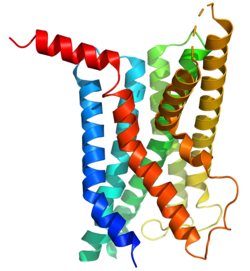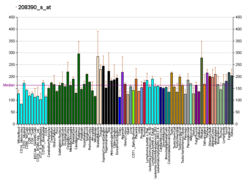The glucagon-like peptide-1 receptor (GLP1R) is a G protein-coupled receptor (GPCR) found on beta cells of the pancreas and on neurons of the brain. It is involved in the control of blood sugar level by enhancing insulin secretion. In humans it is synthesised by the gene GLP1R, which is present on chromosome 6.[5][6] It is a member of the glucagon receptor family of GPCRs.[7] GLP1R is composed of two domains, one extracellular (ECD) that binds the C-terminal helix of GLP-1,[8] and one transmembrane (TMD) domain[9] that binds the N-terminal region of GLP-1.[10][11][12] In the TMD domain there is a fulcrum of polar residues that regulates the biased signaling of the receptor [10] while the transmembrane helical boundaries[13] and extracellular surface are a trigger for biased agonism.[11]
- ^ a b c GRCh38: Ensembl release 89: ENSG00000112164 – Ensembl, May 2017
- ^ a b c GRCm38: Ensembl release 89: ENSMUSG00000024027 – Ensembl, May 2017
- ^ "Human PubMed Reference:". National Center for Biotechnology Information, U.S. National Library of Medicine.
- ^ "Mouse PubMed Reference:". National Center for Biotechnology Information, U.S. National Library of Medicine.
- ^ Thorens B (September 1992). "Expression cloning of the pancreatic beta cell receptor for the gluco-incretin hormone glucagon-like peptide 1". Proceedings of the National Academy of Sciences of the United States of America. 89 (18): 8641–5. Bibcode:1992PNAS...89.8641T. doi:10.1073/pnas.89.18.8641. PMC 49976. PMID 1326760.
- ^ Dillon JS, Tanizawa Y, Wheeler MB, Leng XH, Ligon BB, Rabin DU, et al. (October 1993). "Cloning and functional expression of the human glucagon-like peptide-1 (GLP-1) receptor". Endocrinology. 133 (4): 1907–10. doi:10.1210/endo.133.4.8404634. PMID 8404634.
- ^ Brubaker PL, Drucker DJ (2002). "Structure-function of the glucagon receptor family of G protein-coupled receptors, coupled to: the glucagon, GIP, GLP-1, and GLP-2 receptors" (PDF). Receptors & Channels. 8 (3–4): 179–88. doi:10.1080/10606820213687. PMID 12529935.
- ^ Underwood CR, Garibay P, Knudsen LB, Hastrup S, Peters GH, Rudolph R, Reedtz-Runge S (January 2010). "Crystal structure of glucagon-like peptide-1 in complex with the extracellular domain of the glucagon-like peptide-1 receptor". The Journal of Biological Chemistry. 285 (1): 723–30. doi:10.1074/jbc.M109.033829. PMC 2804221. PMID 19861722.
- ^ Song G, Yang D, Wang Y, de Graaf C, Zhou Q, Jiang S, et al. (June 2017). "Human GLP-1 receptor transmembrane domain structure in complex with allosteric modulators". Nature. 546 (7657): 312–315. Bibcode:2017Natur.546..312S. doi:10.1038/nature22378. PMID 28514449. S2CID 2141649.
- ^ a b Wootten D, Reynolds CA, Koole C, Smith KJ, Mobarec JC, Simms J, et al. (March 2016). "A Hydrogen-Bonded Polar Network in the Core of the Glucagon-Like Peptide-1 Receptor Is a Fulcrum for Biased Agonism: Lessons from Class B Crystal Structures". Molecular Pharmacology. 89 (3): 335–47. doi:10.1124/mol.115.101246. PMC 4767408. PMID 26700562.
- ^ a b Wootten D, Reynolds CA, Smith KJ, Mobarec JC, Koole C, Savage EE, et al. (June 2016). "The Extracellular Surface of the GLP-1 Receptor Is a Molecular Trigger for Biased Agonism". Cell. 165 (7): 1632–1643. doi:10.1016/j.cell.2016.05.023. PMC 4912689. PMID 27315480.
- ^ Yang D, de Graaf C, Yang L, Song G, Dai A, Cai X, et al. (June 2016). "Structural Determinants of Binding the Seven-transmembrane Domain of the Glucagon-like Peptide-1 Receptor (GLP-1R)". The Journal of Biological Chemistry. 291 (25): 12991–3004. doi:10.1074/jbc.M116.721977. PMC 4933217. PMID 27059958.
- ^ Wootten D, Reynolds CA, Smith KJ, Mobarec JC, Furness SG, Miller LJ, et al. (October 2016). "Key interactions by conserved polar amino acids located at the transmembrane helical boundaries in Class B GPCRs modulate activation, effector specificity and biased signalling in the glucagon-like peptide-1 receptor". Biochemical Pharmacology. 118: 68–87. doi:10.1016/j.bcp.2016.08.015. PMC 5063953. PMID 27569426.







